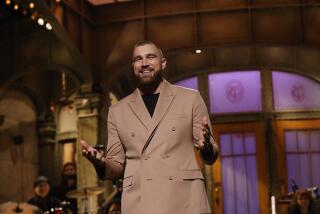Funny Ads Make Comeback
- Share via
Advertisers that primarily limited their messages to somber or patriotic themes immediately after the Sept. 11 terrorist attacks are having some fun again.
Sight gags, word games and other clever twists that turn the human condition on its head are resurfacing in television advertising, but advertisers are handling comedy with care rather than risk offending edgy consumers. Not surprisingly, companies that used humor before Sept. 11 have taken the lead with the funny-bone approach.
The funny stuff will be apparent during commercial breaks in Fox’s Feb. 3 Super Bowl broadcast--in which marketers are paying close to $2 million for 30-second spots--and the Winter Olympic Games, scheduled to start in early February.
Don’t expect a return to the zaniness of two years ago, when cash-rich dot-coms commandeered commercial breaks and acted like ill-mannered children in a candy store. Super Bowl spots and commercials being filmed for NBC’s Winter Olympics coverage don’t exist in a vacuum. Advertising is colored by what’s going on in society, and advertisers know there are limits on what they can do for a laugh.
“People still have a sense of humor, but there’s a carefulness now because it isn’t the time to offend anyone,” said Cheryl Berman, chairwoman and chief creative officer of advertising agency Leo Burnett.
Southwest Airlines, the first airline to return to the airwaves after Sept. 11, in October also was one of the first to begin running funny advertising, including an ad in which a guest heads out of town after being caught rummaging through her host’s medicine cabinet.
The decision wasn’t without risk because all airlines again pulled their commercials Nov. 13, after an American Airlines flight crashed shortly after departing from John F. Kennedy International Airport in New York.
So far, Southwest has run ads created before Sept. 11. Two new spots in production will air this month.
“I wouldn’t say they’re designed to be fall-on-the-floor-laughing hilarious,” said Eric Webber, spokesman for GSD&M;, Southwest’s Austin, Texas-based advertising agency. “But they are lighter. We are slowly moving back in that [humorous] direction.”
Nextel Communications Inc. easily could have decided to promote the life-saving potential of its cellular telephones that double as short-range radios. But new commercials that began to air Sunday instead show “NYPD Blue” star Dennis Franz spoofing celebrities who pitch products for a living. Subsequent commercials will feature blues singer B.B. King and golfer John Daly.
Nextel determined in late October that tasteful humor again had a place in advertising, according to Edward Boches, chief creative officer for Wenham, Mass.-based Mullen, which creates Nextel’s advertising. Some spots, however, no longer passed muster. Nextel pulled a commercial that shows an unlucky guy who tumbled down an elevator shaft because his cell phone provider failed to relay a message about planned elevator repairs.
“Everyone is really sensitive to not inadvertently pushing the wrong button,” Boches said. “There’s a bunch of things you won’t do humor about, including airlines, conspiracies, foreigners, high-rise buildings and lots of other obvious things.”
Humor also has been a staple for Sprint PCS. In October, the company enlisted Daryl Dragon and Toni Tennille, better known as the Captain and Tennille, for a silly spot that began running in November. The ‘70s pop stars are seen belting out one of their hit songs during a football practice after a competitor’s cellular telephone service fumbles the coach’s call for “a replacement for O’Neill.”
“What commercials you did see immediately after Sept. 11 were patriotic, moving and emotional,” Tennille said. “I found myself crying when I turned on the television and saw one of those spots or heard a piece of music. I finally got to the point where I couldn’t keep crying, and I think a lot of people felt like I did, that it was time for a little break.”
Though advertisers are again incorporating humor, they’re studying scripts to determine what’s appropriate.
Bank of America was filming new spots in New Zealand when the terrorist attacks occurred. Unlike past spots, the proposed commercials incorporated humor, so the company had to make a quick decision on whether to continue shooting.
“We couldn’t get out of New Zealand even if we wanted to, so we went ahead with the shoot,” said Frank Sottosanti, a branding and communications executive with Bank of America.
Bank of America also shot a serious commercial just in case consumer research determined that funny stuff wasn’t appropriate. The spots that showcase the bank’s Winter Olympics sponsorship are the foundation of a $60-million campaign.
So the company made a “gut check” in October and opted to go ahead with the funny spots, Sottosanti said. Initially, the spots showed bumbling bank employees falling out of bobsleds and failing to stop hockey players from scoring. But after studying post-Sept. 11 market research, the company changed the endings; now, the bankers gamely return to the field of play for more action.
Bank of America’s last-minute tweaking underscores what Leo Burnett’s Berman describes as a “kinder, more sensitive, gentler” advertising climate prompted by constantly changing consumer attitudes.
Leo Burnett has been monitoring 10,000 Americans to track their attitudes toward advertising. And, simply put, Americans don’t appreciate such sophomoric spots as the Outpost.com advertising two years ago that joked about children being attacked by wolves and gerbils being shot from cannons.
There’s no better venue for funny commercials than the Super Bowl broadcast. Each year, it draws more viewers than any other television program. And ratings for the early commercial breaks often soar higher than the game itself.
There’s clearly room for reflection during the broadcast. Nike “hit exactly the right emotional button” during a Super Bowl spot that aired during the Gulf War, said Kevin L. Keller, a marketing professor at Dartmouth College. The commercial blended footage of a lone runner with black-and-white shots of famous faces who’ve pitched Nike products.
In contrast, Coca-Cola Co. came across as the unwanted party crasher that same year with a preachy commercial that suggested the wartime sports broadcast wasn’t the right venue for jokes. The soft-drink company’s former marketing chief acknowledges that the sober advertisement was a mistake.
There will be plenty of patriotism evident during the Super Bowl broadcast from New Orleans. Some advertisers undoubtedly will wrap themselves in the flag too. Although companies usually keep their Super Bowl ad scripts under wraps, observers say most advertisers suiting up for the big game will try to make viewers laugh.
Levi Strauss & Co., for example, already has invited consumers to visit its Web site and select which of three funny spots deserves to be shown during the Super Bowl.
Advertisers aren’t alone in betting that Americans will be ready for a break Feb. 3. NBC hopes to steal Fox’s halftime thunder by staging its own halftime show on its network. The special edition of “Fear Factor” featuring Playboy centerfold models will begin the exact moment Fox unveils its halftime show headlined by rock band U2.
The Super Bowl isn’t the only sports-marketing challenge facing advertising agency creative types. Olympic Games broadcasts typically are heavy on flag-waving and commercials that bring a tear to viewers’ eyes.
The upcoming broadcast won’t be any different. NBC spots promoting the network’s coverage feature a newly recorded version of Neil Diamond’s “America.”
But Berman cautions that it’s usually easier to hit the funny bone than gently tug at heartstrings.
“You can’t do that kind of work right now if it doesn’t have a smile, if it doesn’t lift you at the end,” Berman said. “Laughter and tears are very close together, and that’s where people’s heads are right now.”
More to Read
Inside the business of entertainment
The Wide Shot brings you news, analysis and insights on everything from streaming wars to production — and what it all means for the future.
You may occasionally receive promotional content from the Los Angeles Times.










